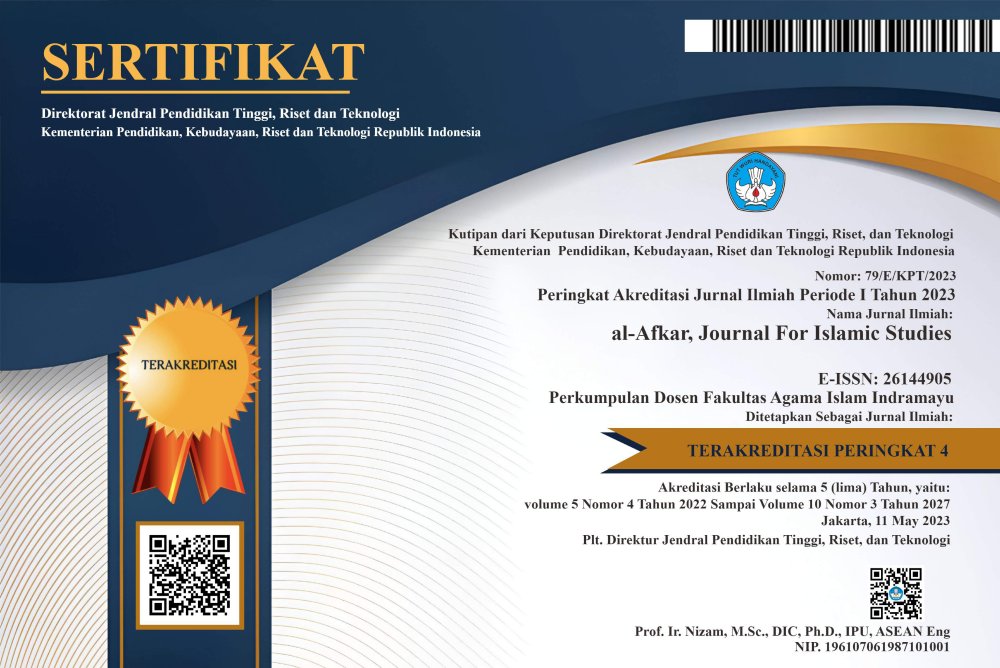The History of the Entry of Islam in the Land of Karo
DOI:
https://doi.org/10.31943/afkarjournal.v7i4.1335Keywords:
History of the Entry of Islam, Tanah Karo, Religion and Culture, Development of Islam, Cultural IdentityAbstract
This research investigates the history of the introduction of Islam in Tanah Karo, a region rich in cultural and historical heritage in Indonesia. Against the backdrop of religious and cultural diversity in Tanah Karo, this research aims to answer the question of how Islam entered and developed in Karo society. The research method used includes a historical study with analysis of literature, archives, and other primary sources. The results revealed that Islam entered Tanah Karo through various channels, including trade and dissemination by ulama. The process of Islam entry was influenced by the social, political and cultural context of Karo society at the time. The conclusion of this study is that the entry of Islam in Tanah Karo was the result of a complex interaction between internal and external factors, and became an integral part of the historical development and cultural identity of the Karo people.
Downloads
References
Abdurrahman, D. (2003). Sejarah Peradaban Islam: Masa Klasik Hingga Modern. LESFI.
Achiriah, & Rohani, L. (2018). Sejarah Peradaban Islam. Perdana Publishing.
Aini, N., Asari, H., & Zuhriah, Z. (2021). Sejarah Kedatukan Urung Sepuluh Dua Kuta Hamparan Perak Kabupaten Deli Serdang, 1823-1946. Warisan: Journal of History and Cultural Heritage, 1(3), 74–79. https://doi.org/10.34007/warisan.v1i3.568
Bangun, R. (1989). Mengenal Orang Karo. Yayasan Pendidikan Bangun.
Creswell, J. (2019). Research Design : Pendekatan Metode Kualitatif, Kwantitatif dan Campuran. Pustaka Pelajar.
Damanik, E. L. (2019). Gugung dan Jehe: Pembelahan Etnik Karo di Sumatrea Utara. Handep: Jurnal Sejarah Dan Budaya, 3(1), 1–32.
Fadilah, S., Lubis, F., & Jamil, K. (2021). Sejarah dan Pelestarian Genderang Sisibah Sebagai Warisan Budaya Suku Pakpak di Kabupaten Dairi. Local History & Heritage, 1(2), 54–62. https://doi.org/10.57251/lhh.v1i2.96
Ginting, M. U. (2013). Adat Karo Sirulo: Tuntunan Praktis Adat Istiadat Karo Jilid I. BPK Gunung Meriah.
Irsyad, M. R., Fitri, H., & Sumantri, P. (2023). Migrasi Muslim India ke Barus Tapanuli Tengah di Abad ke-20 M: Sebuah Tinjauan Sejarah. Local History & Heritage, 3(2), 73–78. https://doi.org/10.57251/lhh.v3i2.1094
Kuntowijoyo. (2013). Pengantar Ilmu Sejarah. Tiara Wacana.
Prints, D. (2012). Adat Karo. Penerbit Bina Media Perintis.
Putro, B. (1995). Sejarah Karo Dari Zaman Ke Zaman. Ulih Saber.
Risalah Seminar Sejarah Masuknya Islam Ke Indonesia. (1963).
Sugiyono. (2017). Metode Penelitian Kuantitatif, Kualitatif, dan R&D. Alfabeta.
Supriyadi, D. (2016). Sejarah Peradaban Islam (Cet. ke-8). Pustaka Setia.
Yatim, B. (2008). Sejarah Peradaban Islam. PT. RajaGrafindo Persada.
Zed, M. (2014). Metode Penelitian Kepustakaan. Yayasan Pustaka Obor Indonesia.
Downloads
Published
How to Cite
Issue
Section
License
Copyright (c) 2024 Diah Syahfitri Chan, Suprayitno, Nursukma Suri

This work is licensed under a Creative Commons Attribution 4.0 International License.



















